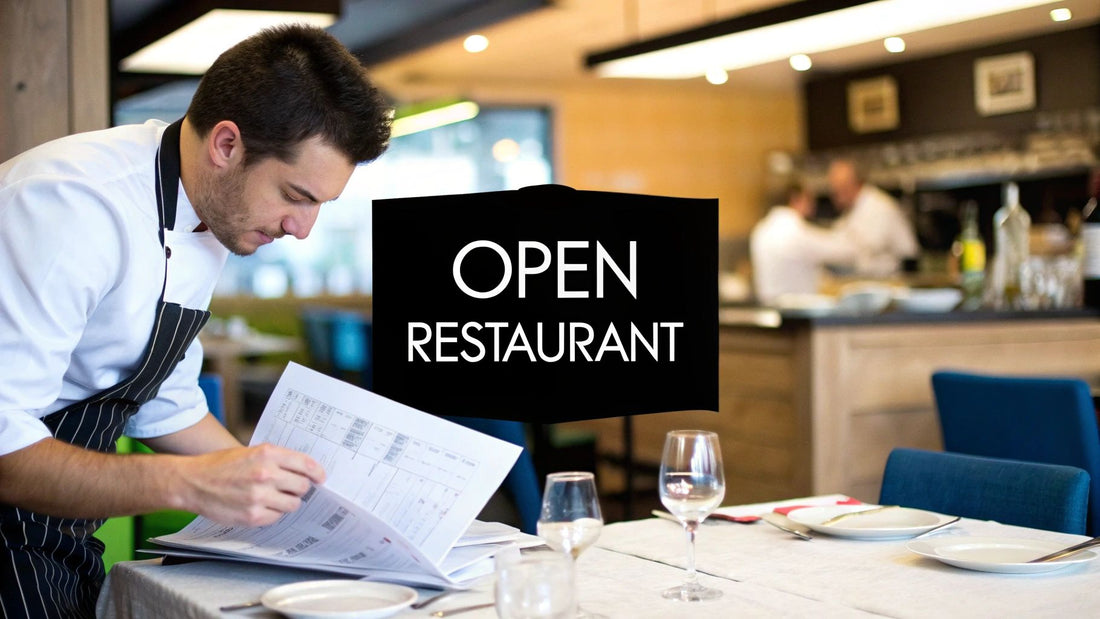
How to Open a Small Pizzeria: Your Easy Startup Guide
Share
So, you've got a killer pizza recipe and a dream of opening your own shop. That’s the fun part. But before you even think about tasting tomato sauces or picking out the perfect pizza prep table, the real work begins. It happens on paper.
This is where you build the blueprint for your business. A strong plan, built on a solid foundation, is what separates the pizzerias that thrive from those that are just a flash in the pan. Think of it as creating the recipe for your business itself—get this right, and everything else gets easier.
Nailing Down Your Pizzeria Concept
First things first: what kind of pizza are you going to make? "Just pizza" isn't an answer. You need a specific, compelling concept that will define your brand, shape your menu, and attract your ideal customers. This decision impacts everything, right down to the type of pizza prep table you'll need.
- Authentic Neapolitan: This is for the purists. It means a blistering-hot oven, specific techniques, and a deep respect for tradition. Your audience will be pizza connoisseurs who appreciate quality over quantity.
- Classic New York Style: Big, foldable slices. This is the crowd-pleaser, perfect for by-the-slice service, takeout, and families looking for a familiar favorite.
- Gourmet or Artisanal: Here’s where you can get creative. Think unique toppings, fusion flavors, and high-end ingredients. You'll be targeting foodies who are willing to pay a little more for something special.
Your concept has to be something you're passionate about, but it also has to fill a gap in your local market.
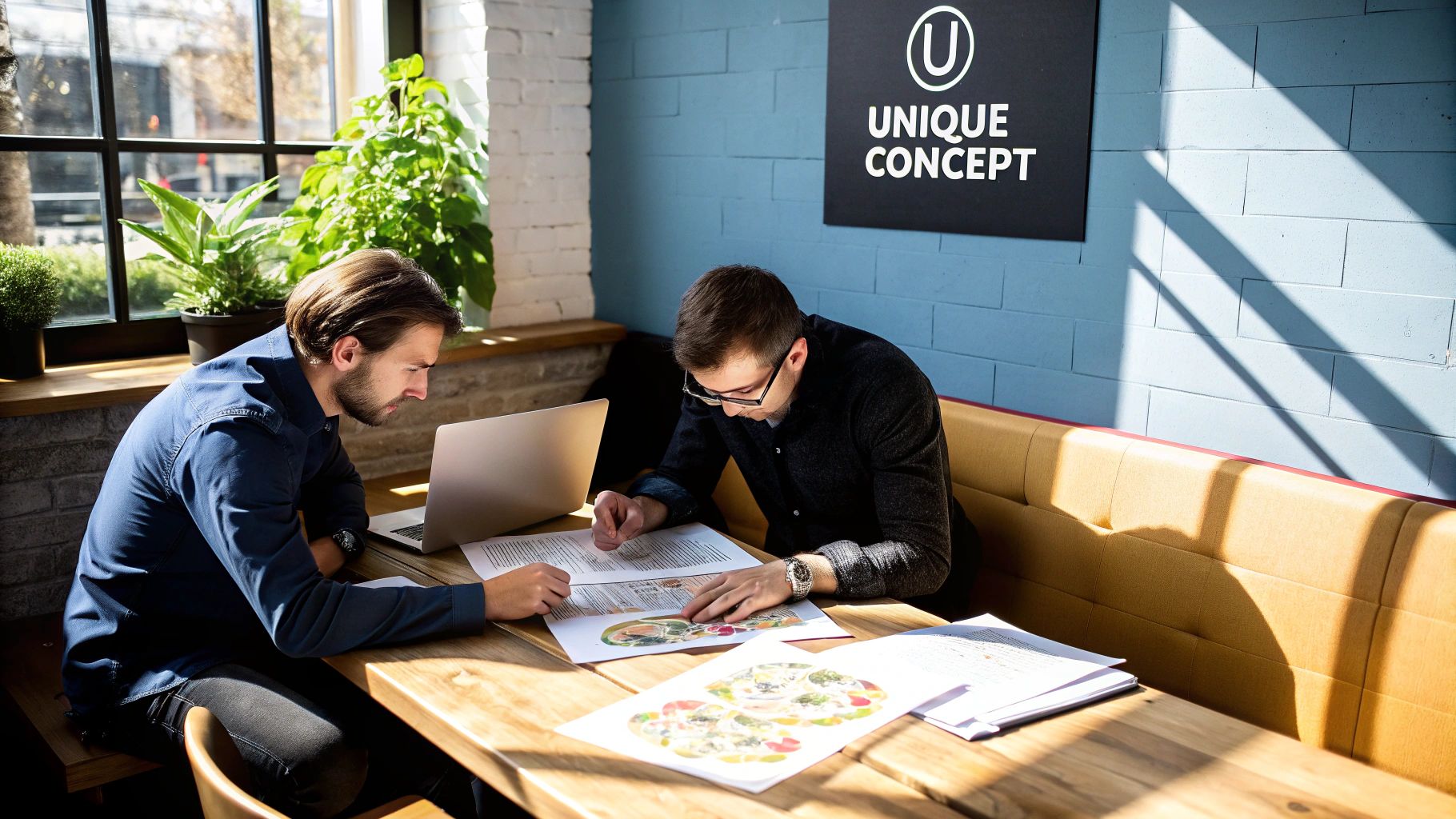
Doing Your Local Market Homework
Once you have a concept, it’s time to become a local pizza detective. You absolutely must understand the neighborhood you plan to serve. Who are your competitors? Who are your potential customers?
Get out there and visit every other pizzeria within a five-mile radius. Seriously. Order their pizza, watch their staff, and check their prices. What are they doing right? Where are they falling short? Maybe every shop is slinging New York-style slices, leaving a wide-open lane for your authentic Neapolitan spot. For a structured way to tackle this, a good checklist for opening a pizzeria can be a lifesaver.
So many people make the mistake of thinking a great product is all it takes. But even the world's best pizza will fail if no one is there to eat it. Your research should be the backbone of your entire business plan.
Getting Real with Financial Projections
Passion is the fuel, but cash is the engine. This next part can feel intimidating, but it’s the most critical step in proving your dream can be a real, profitable pizzeria.
You need to break down your finances into two main buckets:
- Startup Costs: These are all the one-time expenses to get the doors open. We're talking security deposits, legal fees, kitchen equipment like ovens, mixers, and of course, your essential pizza prep tables.
- Operational Expenses: This is the money you'll spend every month just to keep the lights on. Think rent, utilities, payroll, marketing, and your cost of goods—all that flour, cheese, and sauce.
Forecasting your revenue is part art, part science. Start by calculating your seating capacity, estimating how many times a table will "turn" during peak hours, and projecting an average check size. My advice? Be conservative. It’s always better to under-promise and over-deliver, especially when you're talking to potential investors.
Securing Funding and Navigating Legal Requirements
You’ve got a killer pizzeria concept. Now comes the part that turns a great idea into a real, functioning business: money and paperwork. These are often the biggest hurdles for anyone figuring out how to open a small restaurant, but trust me, with a clear strategy, they're completely manageable. Getting your financial and legal house in order from day one isn't just a good idea—it’s non-negotiable for a pizzeria.
Let's be real about the pizza world for a second. It's tough. The industry is incredibly competitive, and success often comes down to solid financial discipline. Globally, about 60% of new restaurants make it through their first year, but that number drops to just 20% surviving past five years.
Initial startup costs for a small pizzeria can easily fall between $100,000 to $500,000. When you’re working with profit margins that average a slim 3% to 6%, there's very little room for error. I'm not telling you this to scare you off, but to drive home just how critical rock-solid financial planning is.
This infographic breaks down the sequence of funding, budgeting, and legal steps you’ll need to tackle.
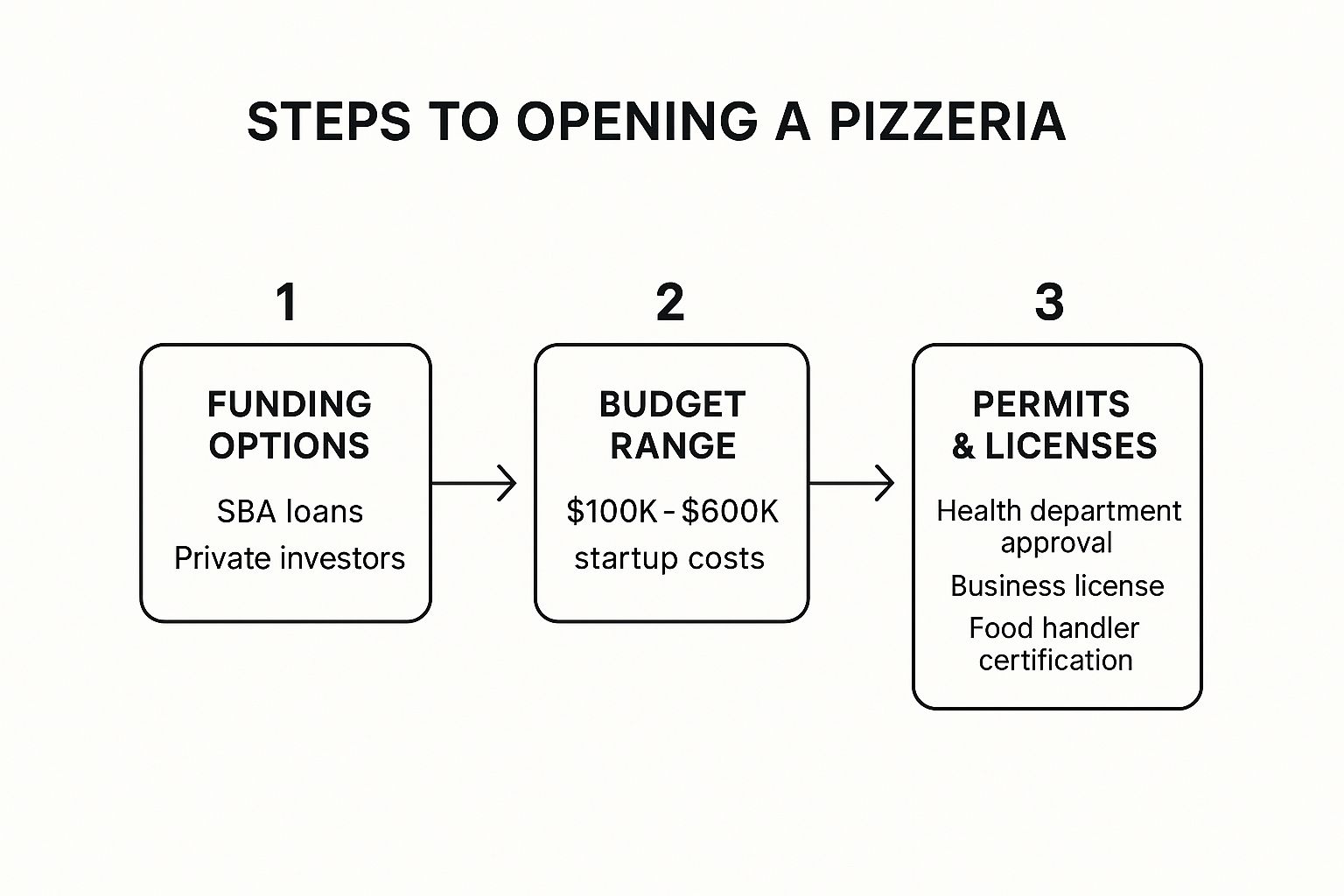
As you can see, the process flows logically. First, you secure the capital. Then, you allocate it wisely. Finally, you make sure you're legally compliant before you even think about opening your doors.
Exploring Your Funding Options
Unless you’re sitting on a pile of cash, you'll need to secure capital to cover those hefty startup costs. The good news is there are several avenues to explore, each with its own pros and cons. Don't put all your eggs in one basket; a mix of funding sources is often the smartest approach for a new pizzeria.
- SBA Loans: Backed by the Small Business Administration, these loans are tailor-made for entrepreneurs like you. They often come with better terms than conventional bank loans because the government guarantee makes lenders feel a lot safer.
- Traditional Bank Loans: If you have a strong credit history and a business plan that’s buttoned up tight, a conventional loan from a local bank or credit union is a solid option. Building a relationship with a local banker can be a huge asset down the road.
- Private Investors or "Friends and Family": Tapping into your personal network can provide that initial seed money. If you go this route, treat it like a formal business deal. Get everything in writing to avoid awkward holiday dinners later.
"Your business plan isn't just a document for you; it's your primary sales tool for lenders and investors. It needs to tell a compelling story backed by realistic numbers and thorough research."
When you're pitching to any potential funder, your financial projections are everything. They want to see you’ve done your homework. You need a detailed breakdown of where every single dollar is going, from the lease deposit to the cost of your pizza prep tables. For a granular look at these expenses, our guide on the complete restaurant startup costs breakdown is an invaluable resource.
Demystifying Permits and Licenses
The paperwork involved in opening a pizzeria can feel like you’re trying to navigate a maze blindfolded. Every city and state has its own unique set of rules, so your first stop should always be your local city hall or county clerk's office. Ask for a definitive checklist.
While the specifics will vary, you can bet you'll need these core permits:
- Business License: This is the fundamental permit to legally operate any business in your area. No getting around it.
- Health Department Permit: Absolutely non-negotiable. Health inspectors will scrutinize your kitchen plans and conduct on-site inspections to ensure you meet all food safety and sanitation codes before you can open.
- Food Handler's Certificate: You and every member of your staff will need to complete training on safe food handling practices.
- Certificate of Occupancy: This certifies that your building is safe for the public and complies with all building and zoning codes for use as a restaurant.
Kick off this process as early as possible. Seriously. Some permits can take weeks, or even months, to get approved. Staying organized and proactive is the only way to avoid costly delays that could push back your grand opening.
Designing an Efficient Pizzeria Kitchen
Your kitchen is the engine room of your pizzeria. It’s the heart of the operation, the place that pumps out every single pie from dough to box. A smart layout isn’t just about making things look nice; it’s the secret to speed, consistency, and keeping your team sane during a Friday night rush. This is where your concept gets real, and the design choices you make now will either help you or haunt you for years.
I’ve seen it time and again: a great menu idea falls flat because the kitchen flow is a disaster. The goal is simple—create a logical path for every pizza. You want to shave off seconds at every step and stop your staff from doing the "kitchen dance" where they're constantly bumping into each other. A well-designed kitchen is organized, not chaotic. It’s what lets you nail that perfect pizza, every single time.
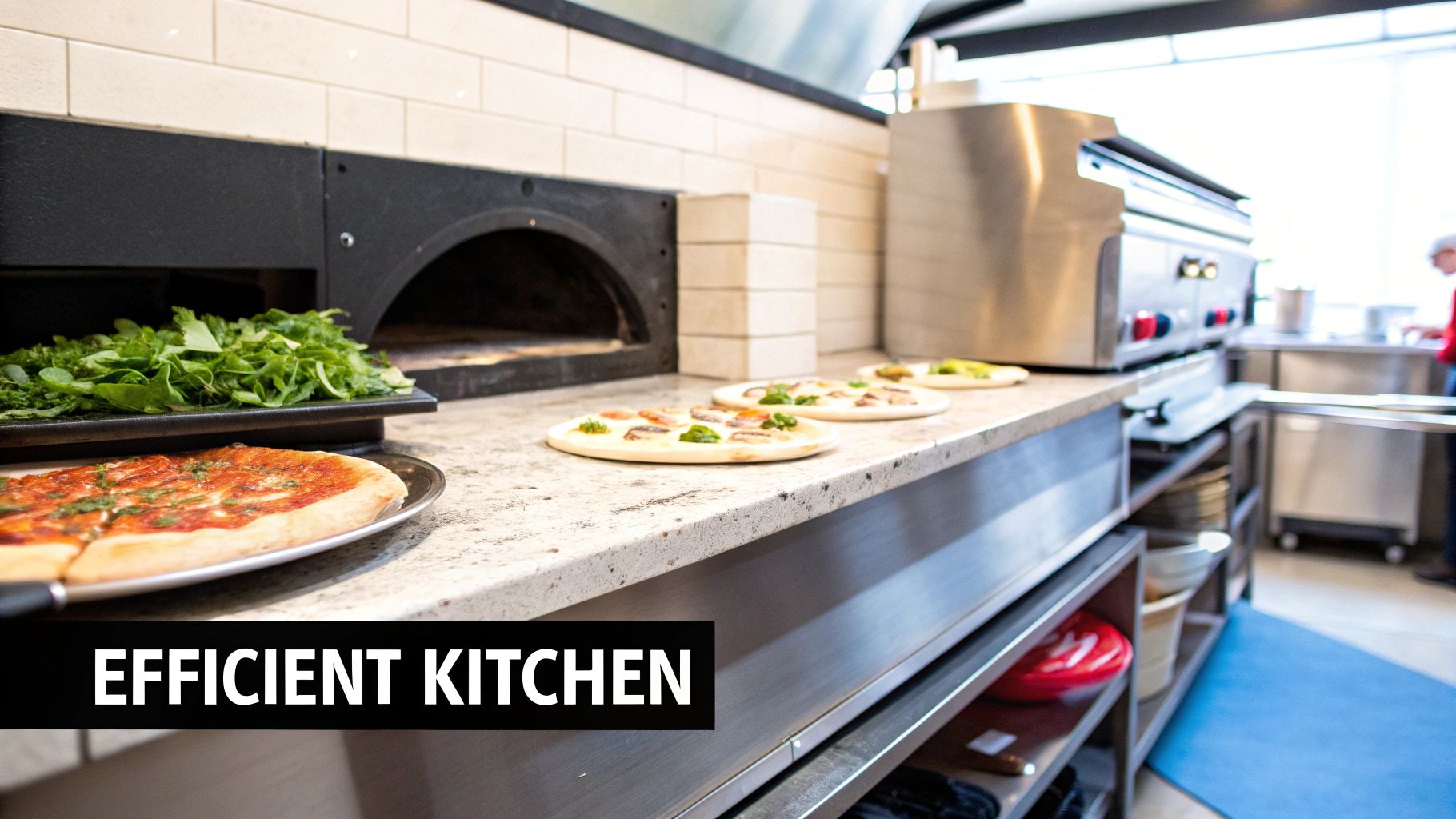
Creating Smart Work Zones
The best pizzeria kitchens I've been in are built around distinct "work zones." Think of it like a finely tuned assembly line. Each zone has every tool and ingredient needed for one specific job, all within arm's reach. This approach is what lets a tiny crew pump out a crazy volume of orders without missing a beat.
Here are the essential zones you absolutely need to plan for:
- Dough Preparation: This is where it all begins. Your commercial mixer should live here, right next to a big stainless steel table for kneading and portioning. Keep your flour and other dry goods close by to avoid unnecessary trips.
- Topping and Assembly: The core of your production line, anchored by the pizza prep table. All your sauces, cheeses, and toppings need to be right there in the refrigerated rail, ready to go.
- Baking Station: This zone is all about the oven. You need a dedicated landing spot for prepped pizzas waiting to go in and for hot pies coming out. Tools like pizza peels and oven brushes have to be stored here—no exceptions.
- Finishing and Boxing: The final stop before a pizza meets the customer. This area needs a large cutting surface, your best pizza cutters, and stacks of boxes in every size you offer. Position it for a smooth handoff to your front-of-house team or delivery drivers.
Getting these zones arranged just right is critical. Whether you go with an island, zone, or pure assembly line layout depends on your space. To really nail this, you can learn more about crafting a highly effective commercial kitchen layout and design and see what fits your shop best.
Selecting the Right Pizza Oven
Let's be clear: your pizza oven is more than just another piece of equipment. It’s the centerpiece of your whole operation. The oven you choose dictates your pizza’s style, your kitchen's rhythm, and even your monthly utility bills. There's no single "best" oven—only the best one for your specific concept.
- Deck Ovens: These are the classic workhorses. They produce that amazing, crisp crust and are fantastic for cooking at super high temperatures. The catch? They require a skilled operator who knows how to rotate pies for a perfect, even bake.
- Conveyor Ovens: If you're all about consistency and speed, a conveyor oven is tough to beat. They are incredibly easy to use—just set the time and temp, and it churns out perfectly cooked pizzas one after another. Great for high-volume shops where consistency is king.
- Brick Ovens: For that authentic, artisanal vibe (and incredible flavor), nothing touches a wood-fired or gas brick oven. They're a huge visual draw for customers and create a unique product, but they have the steepest learning curve and demand serious space and ventilation.
The Cornerstone: Your Pizza Prep Table
While the oven gets all the attention, the pizza prep table is the unsung hero of a productive kitchen. This is where your staff will spend the majority of their time, and its features can make or break your speed. Choosing the right one is one of the most important decisions you'll make.
A great pizza prep table isn't a cost—it's an investment in speed and quality. Every second saved during assembly multiplies over hundreds of orders, directly impacting your bottom line and customer satisfaction.
A functional kitchen design is built on proper storage and food safety, which makes reliable commercial refrigeration systems non-negotiable. Your pizza prep table is brilliant because it combines that critical refrigeration with your primary workspace, keeping every ingredient fresh and right at your fingertips.
When you're picking out a prep table, you’re not just buying a piece of steel. You're designing your workflow. Here's a breakdown of what really matters.
Choosing the Right Pizza Prep Table
| Feature | What to Look For | Impact on Your Workflow |
|---|---|---|
| Refrigerated Rail | An insulated lid and enough pan capacity for all your core toppings. | Keeps ingredients at a safe temperature (below 40°F) and within immediate reach, drastically cutting down on prep time. |
| Cutting Board Depth | A depth of at least 19 inches to comfortably fit your largest pizza size. | Prevents toppings from spilling onto the floor and gives your team ample space to work without feeling cramped. |
| Overall Size & Storage | A length (from 44" to 93") that matches your projected volume and has refrigerated cabinets below. | Provides crucial cold storage for backup ingredients, reducing trips to the walk-in cooler during a busy service. |
At the end of the day, spending wisely on equipment designed for a real pizzeria workflow is one of the smartest moves you can make. A thoughtfully designed kitchen, anchored by a functional prep table and the right oven, sets you up for success from the moment you open your doors.
Crafting a Memorable and Profitable Pizza Menu
Your menu is so much more than a list of food—it’s the single most important marketing tool you own. For a small pizzeria, this document defines your entire identity and dictates your kitchen's workflow from open to close. A truly great menu strikes the perfect balance between creativity, profitability, and practicality.
This is where you decide who you are. Are you the neighborhood spot for timeless classics? A lab for inventive, one-of-a-kind pies? Or maybe a bit of both? The goal is to create something that gets customers excited while being something your team can execute flawlessly, even on a slammed Friday night. Think of it as a strategic document that sets the stage for everything else.
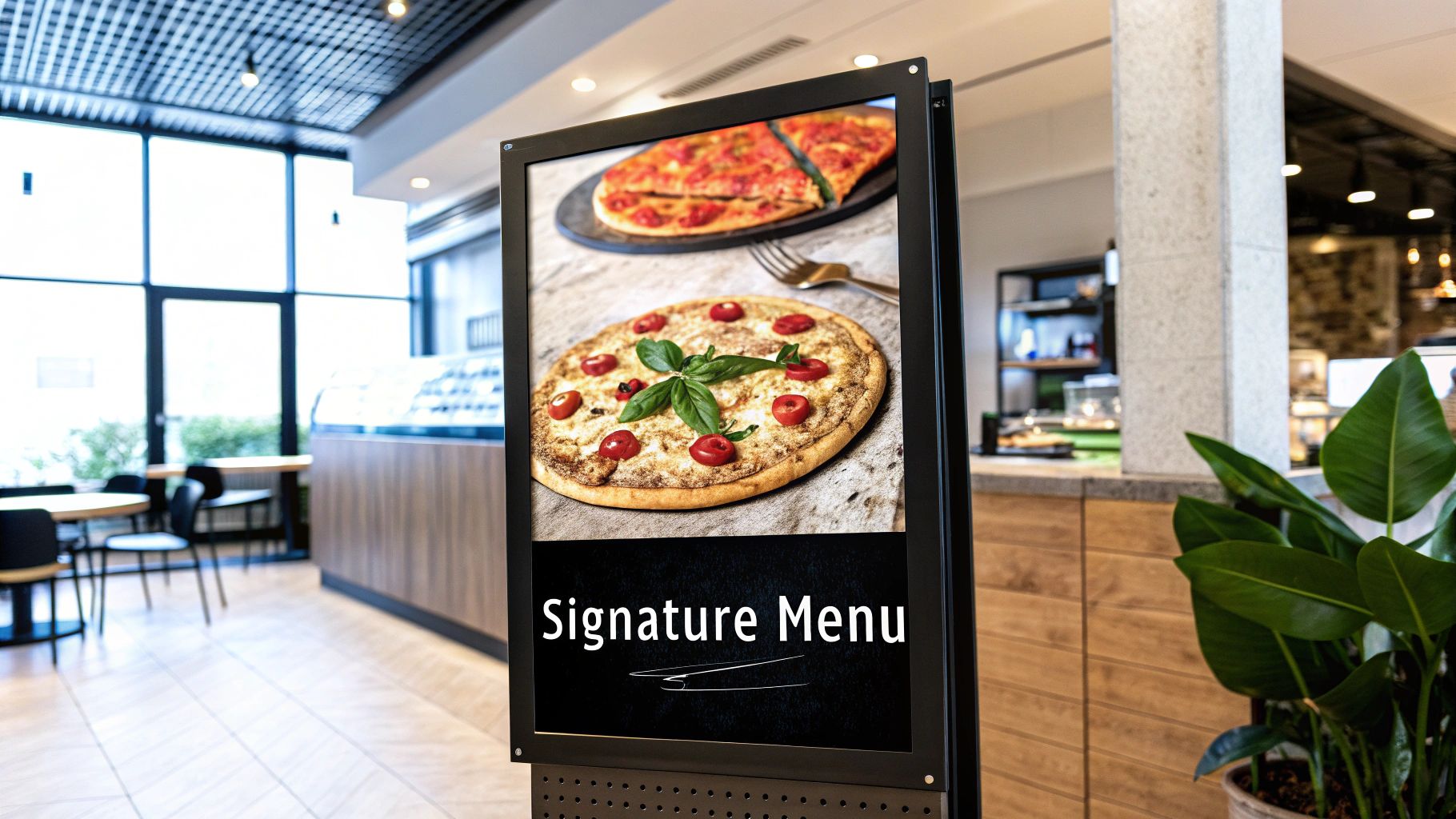
Balancing Classics with Signature Creations
The foundation of any pizzeria menu worth its salt is the classics. You absolutely need a stellar Margherita, a reliable pepperoni, and a solid veggie option. These are the crowd-pleasers that build a loyal following and, frankly, pay the bills.
But to really make a name for yourself, you’ve got to add your own creative spin. This is your chance to introduce one or two signature pizzas that nobody else in town is doing. Maybe it's a pie loaded with unique local ingredients, an unexpected flavor combination, or a special house-made sauce that becomes your claim to fame. The trick is to keep this list short and focused.
A classic mistake I see all the time is creating a sprawling menu with dozens of options. This complicates inventory, slows down your kitchen, and tanks your quality control. A tight, well-executed menu of 8-12 pizzas is infinitely more powerful.
Sourcing Quality and Costing for Profit
The quality of your pizza is a direct reflection of your ingredients. There's no way around it. Forging strong relationships with reliable suppliers for your flour, tomatoes, cheese, and produce is non-negotiable. Don't just hunt for the cheapest option; find partners who deliver consistency and quality, every single time.
Once you have your ingredients locked down, you have to cost out every single item on your menu. I mean everything—calculate the exact price of the dough, sauce, cheese, and each topping for every pizza you sell. Your target food cost should land somewhere between 28% and 35% of the menu price. I know this step is tedious, but it’s absolutely essential for protecting your profit margins.
Tapping into Market Trends
While pizza itself is timeless, customer tastes are always changing. Keeping an eye on broader food trends can be a goldmine for your next hit signature pie. For instance, recent industry data shows that while the pizza category is seeing slower growth, other segments are taking off.
Different restaurant types are seeing varied performance; for example, chicken and Mexican concepts are projected to see sales growth of 6.9% and 6.2%, respectively. Meanwhile, burger, sandwich, and pizza categories are facing more sluggish demand. This doesn't mean pizza is a bad bet—it means there's a massive opportunity for innovation. Adapting menus to local tastes and delivering more value are what will help small pizzerias compete. You can get more details from these restaurant sales forecasts and learn how to adapt.
So what does that data tell you? It could be the inspiration for a new signature pie, like:
- A spicy chipotle chicken pizza with cilantro and lime.
- An "elote" pizza with roasted corn, cotija cheese, and chili powder.
- A killer BBQ chicken pizza with your own house-made sauce.
By thoughtfully balancing beloved classics with a few well-chosen, trend-inspired signature pies, you create a menu that isn't just memorable and delicious, but also efficient and financially sound.
Building Your Team and Launching Successfully
Even with the best kitchen layout and a killer menu, the real secret ingredient to your pizzeria's success is your people. A great team doesn't just make pizza; they create an experience that keeps customers coming back. As you figure out how to open a small restaurant, remember that hiring and training a passionate crew is one of the most important things you'll do.
Let's be honest: the current labor market is tough. Finding and keeping good staff is a real challenge for everyone. Most U.S. restaurants have fewer than 50 employees, and full-service spots typically need between 25-40 people. With a tight labor market, pizzeria owners are getting smarter, using technology to work more efficiently and focusing on building a positive culture with good benefits to attract the best talent. You can get a better sense of the big picture from these restaurant economic trends and insights.
Assembling Your Core Pizzeria Crew
When you're starting out, you don't need a massive team, but you absolutely need the right people in the right roles. I always tell new owners to look for genuine enthusiasm for food and service. You can teach someone how to stretch dough, but you can't teach passion.
Your job description is your first impression. Don't just list a bunch of duties. Tell a story about your pizzeria. What’s the vibe? Are you a loud, fast-paced slice shop or a chill, sit-down spot with craft beer? Be clear about what you value—maybe it's rock-solid reliability, a can-do attitude, or a deep love for pizza.
In the interview, skip the generic questions. Get into real-world scenarios that show you how someone thinks on their feet.
- "A customer is getting antsy because their pizza is taking a while. What do you do?"
- "We just got slammed with 10 online orders all at once. What's your first move?"
- "What's your all-time favorite pizza and why?" (You'd be surprised how much this one reveals about their passion!)
Your first few hires will define your entire company culture. I'd rather have a small, motivated team that clicks than a group of highly skilled individuals who can't work together. Attitude and work ethic trump a long resume every time.
Equipping Your Team with the Right Technology
In a market this competitive, efficiency isn't just a buzzword—it's survival. Modern tech isn't a luxury; it's a tool that empowers your team and makes your life easier. A good Point of Sale (POS) system, for instance, does way more than just take money.
Look for a POS built specifically for pizzerias. It needs to handle the tricky stuff, like half-and-half toppings, and track inventory for key ingredients like dough and mozzarella. A smart POS also integrates smoothly with your online ordering platforms. This frees your staff from mind-numbing manual tasks so they can focus on making incredible pizza and talking to customers.
Scheduling software is another game-changer. It gets rid of the messy paper schedules and endless back-and-forth texts. Employees can see their shifts, request time off, and swap with a manager's approval, all from their phone. It gives your team more control and saves you a massive headache.
Planning a Smart and Successful Launch
Your grand opening is a huge moment. A well-planned launch can create instant buzz and start building a loyal customer base from day one. Instead of one big, chaotic event, I recommend a phased approach.
- Friends and Family Night: Before you open to the public, do a dry run. Host a private night for friends and family. It's a low-pressure way to stress-test your kitchen flow, your POS, and your team in a live but forgiving environment.
- Soft Launch: Open your doors quietly for a week or two. Maybe you have limited hours or a smaller menu. This "soft opening" gives your crew time to find their rhythm and work out the kinks before you're facing a Friday night rush.
- The Grand Opening: Now you're ready to make some noise. Hype it up on local social media groups, reach out to food bloggers in your area, and maybe run a special offer to get people in the door.
As you gear up for your launch, getting your local search presence dialed in is critical. When someone in your neighborhood searches for "pizza near me," you need to be the first thing they see. This ultimate guide to local SEO for small businesses is a great resource to make sure you nail it. A great launch isn't just about one day; it's about building momentum that will carry you forward.
Common Questions About Opening a Pizzeria
Jumping into the world of pizza is exciting, but it definitely brings up a lot of questions. I’ve talked with countless aspiring pizzeria owners over the years, and the same handful of concerns always seem to pop up. Let's break down the big ones so you can move forward with a bit more confidence.
How Much Does It Really Cost to Open a Small Pizzeria?
This is always the first question, and for good reason. The budget is everything. For a small pizza shop, you should plan for startup costs to fall somewhere between $100,000 and $500,000. Yes, that’s a huge range, but it really boils down to your location, how much renovation you need to do, and the level of equipment you’re investing in.
A few of the big-ticket items you'll hit right away are:
- Lease deposits and the first couple of rent payments.
- Kitchen equipment—think ovens, mixers, and especially your pizza prep tables.
- Stocking up on your initial food and beverage inventory.
- The mountain of licenses and permits you'll need.
- Your Point of Sale (POS) system and other tech.
- A marketing budget to make some noise for your grand opening.
Trust me on this: creating a detailed, line-by-line budget isn't just a good idea. It's the only way to avoid running out of cash six months after you open.
What Is the Most Important Piece of Pizzeria Equipment?
Every piece of equipment in your kitchen has a job, but the pizza oven is the undeniable heart of your entire operation. The type you choose—whether it's a workhorse deck oven, a high-volume conveyor, or a classic brick oven—fundamentally defines the kind of pizza you'll make and how fast you can get it to customers.
But here’s a piece of advice from the trenches: don't overlook the unsung hero, the pizza prep table. The layout and features of this one piece of equipment, from its refrigerated rail down to the depth of the cutting board, have a massive impact on your kitchen’s efficiency. A great prep table creates a smooth, stress-free production line, making it one of the most critical investments for your restaurant's daily sanity and performance.
What Are the Biggest Mistakes New Pizzeria Owners Make?
It's a tough business, and many new owners stumble over the same hurdles. If you can sidestep these common pitfalls, you're already way ahead of the game.
I’ve seen that the most successful new pizzerias are the ones that planned for the worst-case scenario. Underestimating your capital needs or the importance of a smooth kitchen workflow can create problems that are very difficult to fix once you're open.
Here are the three biggest mistakes I see time and time again:
- Underestimating Capital Needs: Running out of cash in the first year is a tragically common and often fatal mistake. Always have more runway than you think you need.
- Neglecting Local Marketing: A lot of people believe that if they make great pizza, customers will just show up. That’s a fantasy. You need a real strategy to get people in the door.
- Designing an Inefficient Kitchen: A poorly planned layout is a recipe for disaster. It creates bottlenecks and chaos during your busiest hours, which burns out your staff and tanks your service quality.
How Many Staff Members Do I Need for a Small Pizza Shop?
For a small, counter-service spot, you can often get off the ground with a lean but mighty team of four to six people. This core crew would likely include one or two dedicated pizza makers, someone to handle the register and phones, and another one or two support staff to keep things moving.
The real key is to hire versatile people and cross-train them. You need employees who can jump between stations and handle multiple roles during a single shift. A small, motivated team that genuinely works well together isn't just a goal—it's your single greatest asset.
At Pizza Prep Table, we understand that the right equipment is the foundation of an efficient and successful pizzeria. Our selection of high-quality, NSF-compliant refrigerated pizza prep tables is designed to optimize your workflow and ensure food safety from day one. Explore our range of models to find the perfect fit for your new restaurant. Learn more at https://pizzapreptable.com.
